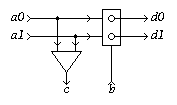EDIS:
Guide |
FAQ |
New |
Search |
Bibliography |
Index |
Feedback
Call
Informal
A (non-arbitrating, blocking) Call has
three input terminals (a0, a1, b) and
three output terminals (c, d0, d1).
A signal appearing on either of the a_i terminals will cause
a signal to be produced at terminal c.
The combination of a signal at terminal a_i and
terminal b will cause a signal to be produced at
terminal d_i.
It does not matter which of the two input signals arrives first.
The environment of
a Call must guarantee mutual exclusion of
the signals on a0 and a1.
The a_i and c signals alternate,
the a_i and d_i signals alternate, and
the b and d_i signals alternate.
Schematic diagram
for a Call:

[Zoom|FIG]
XDI state graph
for a Call:

[Zoom|FIG]
Specification in XDI model.
Specification in Verdect:
define CALL( a0?, d0!, a1?, d1!, c!, b? ) =
pref *[ (a0? | a1?); c! ]
|| pref *[ (a0? || b?); d0!
| (a1? || b?); d1!
]
end
Also available through this link
Specification in DI Algebra:
NAME = Call
I = { a0, a1, b }
O = { d0, d1, c }
CALL = [a0? -> c!; C0, a1? -> c!; C1]
C0 = [b? -> d0!; CALL, a0? -> CHAOS, a1? -> CHAOS]
C1 = [b? -> d1!; CALL, a0? -> CHAOS, a1? -> CHAOS]
.
Also available through this link
XDI Report.
The roles of subscripts 0 and 1 can be interchanged:
CALL(a0, d0, a1, d1, c, b) =
CALL(a1, d1, a0, d0, c, b)
In [Dickson74, p. 46],
a Call does not appear as such,
but it is mentioned that a CALL element
(what we refer to as Decision Call)
may be used as a `Simple Call'.
It is not clear from the informal description given there
when new input signals can be offered.
In particular, it is not clear whether a new input signal on b
must await output signal c,
that is, whether b is enabled in state 9.
References
[Dickson74, p. 46]
[Ornstein67, p. 345]
Last modified at Fri Nov 20 10:11:39 1998
Encyclopaedia of Delay-Insensitive Systems
Copyright © 1995-1998
Tom Verhoeff /
Tom.Verhoeff@acm.org


